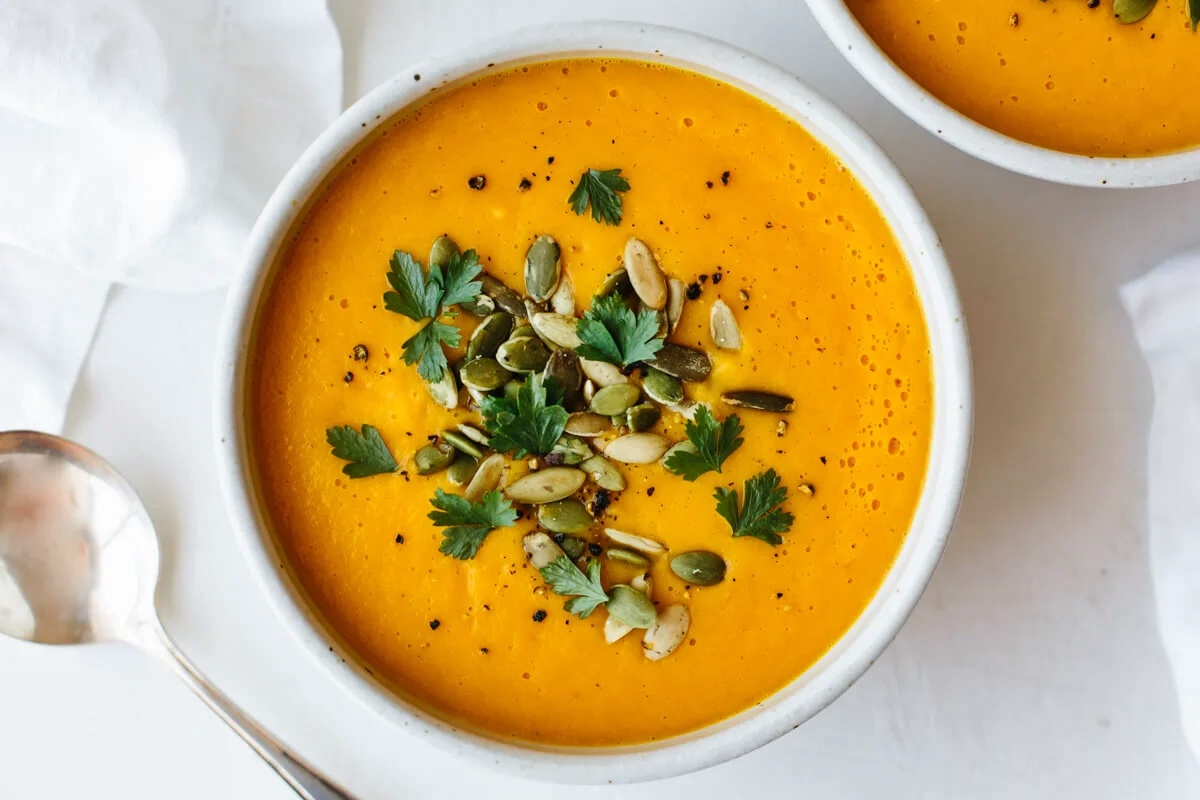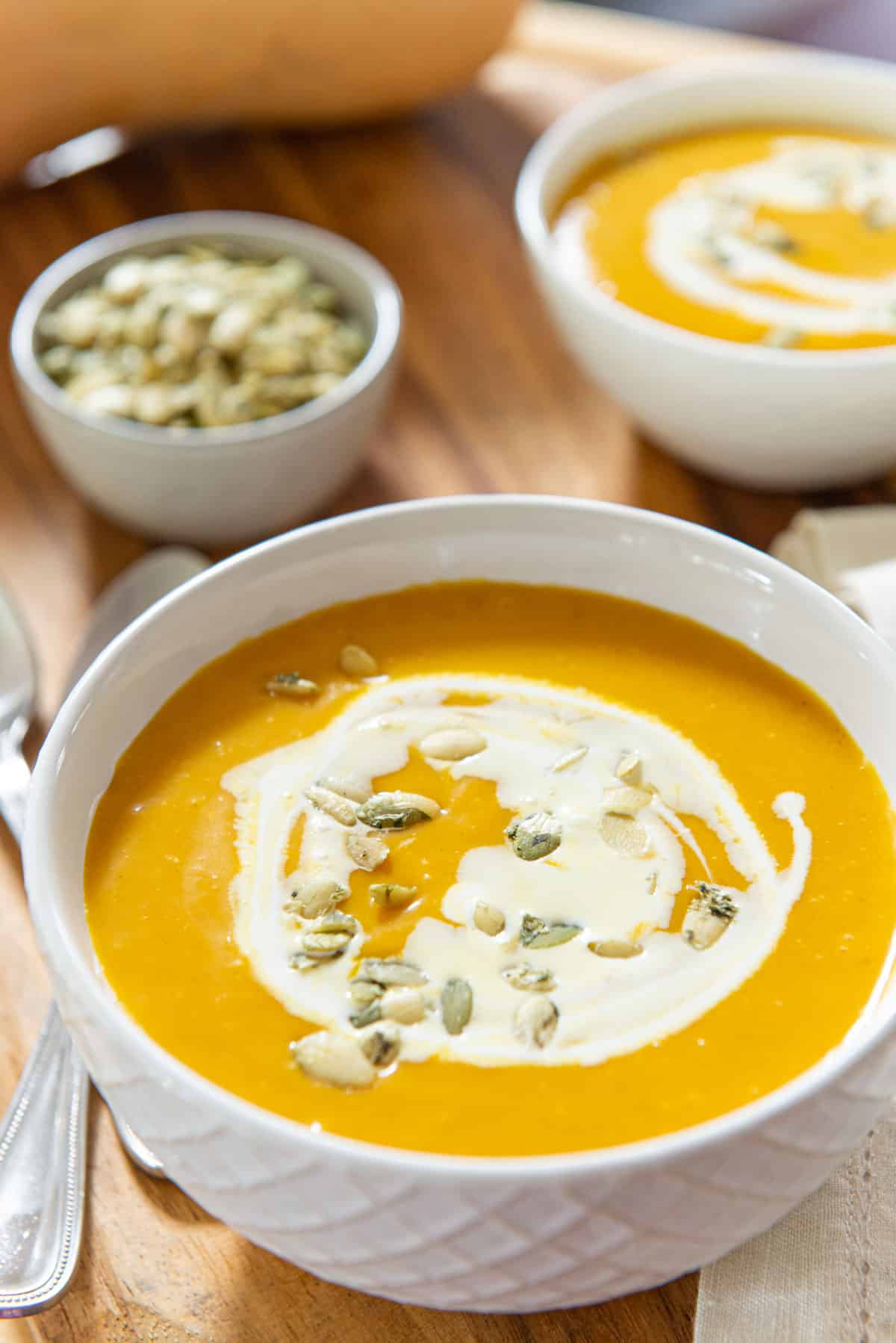
Embracing the Hearth: Crafting Creamy Native American Squash Soup
The crisp air of autumn, the rustle of leaves, and the earthy aroma of ripening gourds – these are the sensory harbingers of a season that calls for warmth, comfort, and the embrace of ancestral flavors. Among the culinary treasures of Native American traditions, squash soup stands as a testament to resourcefulness, seasonality, and the profound connection to the land. More than just a dish, it’s a vessel of history, carrying stories of sustenance, community, and gratitude.
While countless variations exist across the diverse tapestry of Native American tribes, a common thread often emerges: the transformative power of squash, enhanced by simple yet profound seasonings and, in many interpretations, a velvety creaminess that elevates it from a mere soup to a soul-soothing elixir. This article delves into the heart of crafting a deliciously creamy Native American-inspired squash soup, exploring the key ingredients, techniques, and the cultural significance that imbues this dish with its special character.
The Essence of Native American Squash Soup: Beyond the Recipe

Before we embark on the culinary journey, it’s vital to understand that "Native American squash soup" is not a monolithic entity. Each tribe, each family, each individual cook possesses their own unique interpretations, shaped by local ingredients, ancestral knowledge, and personal preferences. The principles we explore here are a synthesis of common threads, designed to capture the spirit and flavor profile often associated with these traditional dishes.
The core of any squash soup lies in the squash itself. Native Americans cultivated a remarkable array of squash varieties, many of which are still cherished today. These include:
-
Winter Squash: These are the stars of autumn and winter, characterized by their hard rinds and dense, sweet flesh. Examples include:
- Butternut Squash: With its pear-like shape and nutty, sweet flavor, butternut is a popular and accessible choice.
- Acorn Squash: Its distinctive ridges and slightly sweet, nutty taste make it a delightful option.
- Kabocha Squash: Known for its deep green rind and vibrant orange flesh, kabocha offers a rich, earthy sweetness.
- Hubbard Squash: These large, hard-shelled squashes possess a dense, sweet, and sometimes slightly fibrous flesh.
- Pumice Squash (e.g., varieties like ‘Navajo’ or ‘Cherokee’ types): These heirloom varieties often boast unique textures and flavor profiles, reflecting specific tribal agricultural practices.

-
Summer Squash: While less common in traditional "creamy" autumn soups, some tribes may have incorporated certain summer squash varieties or used dried versions.
The "creamy" aspect of this soup is often achieved through natural means, reflecting a deep understanding of food and its properties. Instead of relying solely on dairy (which may not have been historically widespread in all regions or for all tribes), traditional methods often involved:
- The Squash Itself: The natural starch and moisture content of certain squashes, when cooked down and blended, create a naturally thick and creamy texture.
- Adding Water or Broth: As the squash cooks and softens, the liquid helps to create a smooth base.
- Optional Natural Thickeners: In some traditions, ingredients like ground nuts (e.g., pine nuts, walnuts) or even a small amount of cornmeal might have been used to add body and richness.
- Modern Adaptations: Today, many recipes incorporate dairy (heavy cream, milk) or non-dairy alternatives (coconut milk, cashew cream) for an undeniably luxurious creaminess. This article will explore both traditional and modern approaches to achieving this.
Key Ingredients for a Creamy Native American Squash Soup:
-
The Squash: As mentioned, choose your preferred winter squash. For ease of preparation and a reliably sweet flavor, butternut squash is an excellent starting point. Roasting the squash before pureeing can intensify its sweetness and add a lovely depth of flavor.
-
Aromatic Foundation:
- Onions: Sweet onions or yellow onions provide a gentle sweetness and savory base.
- Garlic: A few cloves of garlic add pungency and complexity.
- Optional: Leeks or Shallots: These can offer a more nuanced sweetness and milder onion flavor.
-
Liquid Base:
- Water or Vegetable Broth: Unsalted or low-sodium vegetable broth is a good choice for adding depth without overpowering the squash flavor.
- Chicken Broth (for non-vegetarian versions): If not strictly adhering to vegetarian or vegan traditions, chicken broth can add a richer savory note.
-
Seasonings and Spices: This is where the subtle magic happens, reflecting the ingenuity of Native American culinary practices.
- Salt and Black Pepper: Essential for bringing out the flavors.
- Cinnamon: A touch of cinnamon can enhance the natural sweetness of the squash and add a warm, comforting aroma.
- Nutmeg: A pinch of freshly grated nutmeg offers a warm, slightly sweet, and pungent note that pairs beautifully with squash.
- Optional: Sage: Fresh or dried sage can impart an earthy, slightly peppery flavor that is reminiscent of the outdoors and traditional cooking.
- Optional: Allspice or Clove: Used sparingly, these can add a deeper, more complex warmth.
- Optional: A pinch of Cayenne Pepper or Red Pepper Flakes: For a subtle hint of heat that awakens the palate.
-
For Creaminess (Traditional & Modern Approaches):
- The Squash Itself: As the primary emulsifier.
- Milk or Cream (Dairy): For a classic rich and creamy texture.
- Coconut Milk (Full-Fat): An excellent dairy-free alternative that adds a tropical richness and subtle sweetness.
- Cashew Cream: Soaked and blended cashews create a remarkably smooth and neutral-flavored creamy element.
- A Spoonful of Nut Butter (e.g., Tahini or Almond Butter): Can add richness and a subtle nutty depth.
-
Garnishes (for texture and visual appeal):
- Toasted Pepitas (Pumpkin Seeds): A nod to the origin of squash and a delightful crunch.
- A Swirl of Cream or Coconut Milk: For visual appeal and an extra touch of richness.
- Fresh Herbs: Chopped parsley, chives, or a sprinkle of fresh sage.
- Croutons: Toasted cubes of bread.
- A Drizzle of Maple Syrup: To highlight the inherent sweetness of the squash.
The Art of Preparation: Techniques for Creaminess
The path to a creamy squash soup involves a few key techniques:
-
Roasting vs. Boiling: While boiling squash is a simpler method, roasting it first caramelizes its natural sugars, resulting in a deeper, sweeter flavor and a more desirable texture for pureeing. This step is highly recommended for achieving the best taste and creaminess.
-
Softening the Aromatics: Sautéing onions and garlic until they are soft and translucent is crucial for building a flavorful base without any raw onion or garlic bite.
-
Simmering for Flavor Infusion: Allowing the squash and aromatics to simmer in the liquid base allows the flavors to meld and deepen.
-
Pureeing to Perfection: This is the most critical step for achieving creaminess.
- Immersion Blender: The easiest and most convenient method for pureeing directly in the pot.
- Standard Blender: For an exceptionally smooth and silky texture, a standard blender is ideal. Be sure to work in batches and vent the lid to avoid steam buildup.
- Food Processor: Can also be used, though it might result in a slightly less smooth texture than a high-powered blender.
-
Emulsification: The process of blending helps to break down the squash into tiny particles suspended in the liquid, creating the creamy emulsion. Adding your chosen creamy element (dairy, coconut milk, etc.) at the end and blending further helps to integrate it seamlessly.
A Taste of Tradition: The Cultural Significance
Squash has been a staple food for Native American peoples for millennia, cultivated alongside corn and beans as part of the "Three Sisters" agricultural system. This symbiotic planting method, where corn provides a stalk for beans to climb, beans fix nitrogen in the soil, and squash shades the ground to retain moisture and suppress weeds, is a profound example of ecological wisdom and sustainable living.
Squash soup, in this context, represents more than just nourishment. It embodies:
- Gratitude for the Harvest: A celebration of the bounty provided by the earth.
- Community and Sharing: Soups are often communal dishes, prepared and shared among families and communities, fostering connection and togetherness.
- Resourcefulness and Sustainability: Utilizing readily available, seasonal ingredients in a way that maximizes flavor and nutrition.
- Ancestral Knowledge: The transmission of culinary techniques and food traditions from one generation to the next.
When you prepare and savor a bowl of Native American-inspired squash soup, you are not just enjoying a delicious meal; you are participating in a rich cultural heritage, connecting with the wisdom of those who came before.
Recipe: Creamy Native American-Inspired Butternut Squash Soup
This recipe offers a balanced approach, incorporating the natural creaminess of butternut squash with the option to enhance it further with dairy or non-dairy alternatives.
Yields: 6-8 servings
Prep time: 20 minutes
Cook time: 45-60 minutes
Ingredients:
- 1 large butternut squash (about 2.5-3 lbs), peeled, seeded, and cut into 1-inch cubes
- 2 tablespoons olive oil or other cooking oil
- 1 large yellow onion, chopped
- 2 cloves garlic, minced
- 4 cups vegetable broth (low-sodium recommended)
- 1 teaspoon ground cinnamon
- ½ teaspoon ground nutmeg
- ½ teaspoon salt, or to taste
- ¼ teaspoon black pepper, or to taste
- Optional for extra creaminess: ½ cup heavy cream, coconut milk (full-fat), or cashew cream
- Optional garnishes: toasted pepitas, fresh parsley, a swirl of cream/coconut milk, drizzle of maple syrup
Instructions:
-
Roast the Squash (Recommended for best flavor):
- Preheat oven to 400°F (200°C).
- Toss the butternut squash cubes with 1 tablespoon of olive oil, a pinch of salt, and pepper on a baking sheet.
- Spread in a single layer and roast for 25-35 minutes, or until fork-tender and lightly caramelized.
-
Sauté Aromatics:
- While the squash is roasting, heat the remaining 1 tablespoon of olive oil in a large pot or Dutch oven over medium heat.
- Add the chopped onion and sauté until softened and translucent, about 5-7 minutes.
- Add the minced garlic and cook for another minute until fragrant, being careful not to burn it.
-
Simmer the Soup:
- Add the roasted butternut squash cubes (or raw, if skipping roasting) to the pot with the onions and garlic.
- Pour in the vegetable broth.
- Add the cinnamon, nutmeg, salt, and pepper.
- Bring the mixture to a boil, then reduce heat to low, cover, and simmer for 20-25 minutes, or until the squash is very tender. If using raw squash, simmer until completely soft.
-
Puree the Soup:
- Using an Immersion Blender: Carefully insert an immersion blender into the pot and blend until the soup is smooth and creamy.
- Using a Standard Blender: Working in batches, carefully ladle the soup into a standard blender. Fill the blender no more than halfway, remove the center cap from the lid, and cover the opening with a folded kitchen towel to allow steam to escape. Blend until smooth and creamy. Return the pureed soup to the pot.
-
Add Creaminess (Optional):
- If desired, stir in the heavy cream, coconut milk, or cashew cream. Heat gently over low heat, stirring constantly, until warmed through. Do not boil after adding dairy or cream.
-
Adjust Seasoning and Serve:
- Taste the soup and adjust salt and pepper as needed.
- Ladle the creamy squash soup into bowls.
- Garnish with toasted pepitas, fresh parsley, a swirl of cream or coconut milk, or a drizzle of maple syrup, if desired.
Enjoy this comforting and nourishing soup, a delicious homage to the culinary traditions of Native American peoples.


